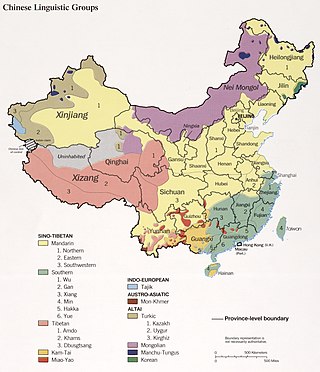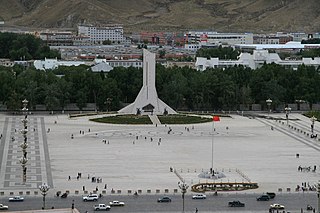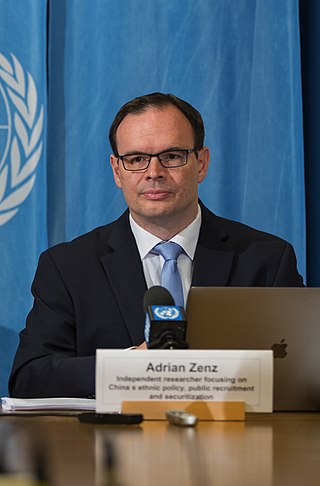
There are several hundred languages in China. The predominant language is Standard Chinese, which is based on Beijingese, but there are hundreds of related Chinese languages, collectively known as Hanyu, that are spoken by 92% of the population. The Chinese languages are typically divided into seven major language groups, and their study is a distinct academic discipline. They differ as much from each other morphologically and phonetically as do English, German and Danish, but meanwhile share the same writing system (Hanzi) and are mutually intelligible in written form. There are in addition approximately 300 minority languages spoken by the remaining 8% of the population of China. The ones with greatest state support are Mongolian, Tibetan, Uyghur and Zhuang.
Education in China is primarily managed by the state-run public education system, which falls under the Ministry of Education. All citizens must attend school for a minimum of nine years, known as nine-year compulsory education, which is funded by the government.

Education in Singapore is managed by the Ministry of Education (MOE). It controls the development and administration of state schools receiving taxpayers' funding, but also has an advisory and supervisory role in respect of private schools. For both private and state schools, there are variations in the extent of autonomy in their curriculum, scope of taxpayers' aid and funding, tuition burden on the students, and admission policy.
The Special Assistance Plan is a programme in Singapore introduced in 1979 which caters to academically strong students who excel in both their mother tongue as well as English. It is available only in selected primary and secondary schools. In a SAP school, several subjects may be taught in the mother tongue, alongside other subjects that are taught in English. SAP schools currently cater only to those studying Mandarin as their mother tongue although theoretically, future SAP schools for other mother tongues are a possibility.

Lhasa Tibetan, or Standard Tibetan, is the Tibetan dialect spoken by educated people of Lhasa, the capital of the Tibetan Autonomous Region of China. It is an official language of the Tibet Autonomous Region.

Tibet University is a public university in Lhasa, Tibet, China. The university is one of China's key universities and the largest university in the Tibet Autonomous Region. With an internationally renowned department of Tibetan studies and a majority ethnic Tibetan student body, the university maintains a focus on local communities and cultures.
Racism in China arises from Chinese history, nationalism, sinicization, and other factors. Racism in modern China has been documented in numerous situations. Ethnic tensions have led to numerous incidents in the country such as the Xinjiang conflict, the ongoing internment and state persecution of Uyghurs and other ethnic minorities, the 2010 Tibetan language protest, the 2020 Inner Mongolia protests, discrimination against Africans in particular and discrimination against Black people in general.

The history of Tibet from 1950 to the present includes the Chinese invasion of Tibet in 1950, and the Battle of Chamdo. Before then, Tibet had been a de facto independent nation. In 1951, Tibetan representatives in Beijing signed the Seventeen-point Agreement under duress, which affirmed China's sovereignty over Tibet while it simultaneously provided for an autonomous administration led by Tibet's spiritual leader, and then-political leader, the 14th Dalai Lama. During the 1959 Tibetan uprising, when Tibetans arose to prevent his possible assassination, the Dalai Lama escaped from Tibet to northern India where he established the Central Tibetan Administration, which rescinded the Seventeen-point Agreement. The majority of Tibet's land mass, including all of U-Tsang and areas of Kham and Amdo, was officially established in 1965 as Tibet Autonomous Region, within China.

The Central Institute of Higher Tibetan Studies, formerly called Central University for Tibetan Studies (CUTS), is a Deemed University founded in Sarnath, Varanasi, India, in 1967, as an autonomous organisation under Union Ministry of Culture. The CIHTS was founded by Pt. Jawahar Lal Nehru in consultation with Tenzin Gyatso, the 14th Dalai Lama, with the aim of educating Tibetan youths in exile and Himalayan border students as well as with the aim of retranslating lost Indo-Buddhist Sanskrit texts that now existed only in Tibetan, into Sanskrit, to Hindi, and other modern Indian languages.

Sinicization of Tibet includes the programs and laws of the Chinese government and the Chinese Communist Party (CCP) which force "cultural unity" in Tibetan areas of China, including the Tibet Autonomous Region and surrounding Tibetan-designated autonomous areas. The efforts are undertaken by China in order to remake Tibetan culture into mainstream Chinese culture.
Human rights in Tibet is a contentious issue. Even though the United States advocates the human rights of the Tibetan people and even though it once provided funds to the Dalai Lama's independence movement, the United States does not participate in the Tibetan sovereignty debate and as a result, it does not recognize Tibet's right to exist as a country. Reported abuses of human rights in Tibet include restricted freedom of religion, belief, and association; arbitrary arrest; maltreatment in custody, including torture; and forced abortion and sterilization. The status of religion, mainly as it relates to figures who are both religious and political, such as the exile of the 14th Dalai Lama, is a regular object of criticism. Additionally, freedom of the press in China is absent, with Tibet's media tightly controlled by the Chinese leadership, making it difficult to accurately determine the scope of human rights abuses.
The community of Nepalis in China consists of Nepalese immigrants and expatriates to China as well as Chinese citizens of Nepalese descent.
Singapore embraces an English-based bilingual education system. Students are taught subject-matter curriculum with English as the medium of instruction, while the official mother tongue of each student - Mandarin Chinese for Chinese, Malay for Malays and Tamil for South Indians – is taught as a second language. Additionally, Higher Mother Tongue (HMT) is offered as an additional and optional examinable subject to those with the interest and ability to handle the higher standards demanded by HMT. The content taught to students in HMT is of a higher level of difficulty and is more in-depth so as to help students achieve a higher proficiency in their respective mother tongues. The choice to take up HMT is offered to students in the Primary and Secondary level. Thereafter, in junior colleges, students who took HMT at the secondary level have the choice to opt out of mother tongue classes entirely. Campaigns by the government to encourage the use of official languages instead of home languages have been largely successful, although English seems to be becoming the dominant language in most homes. To date, many campaigns and programmes have been launched to promote the learning and use of mother tongue languages in Singapore. High ability students may take a third language if they choose to do so.

Chen Quanguo is a retiring Chinese politician and the current deputy head of the CCP Central Rural Work Leading Group. Between 2017 and 2022, he was a member of the 19th Politburo of the Chinese Communist Party and was previously the Chinese Communist Party Committee Secretary of Tibet Autonomous Region from 2011 to 2016 and of the Xinjiang Uyghur Autonomous Region from 2016 to 2021, making him the only person to serve as the Party Secretary for both autonomous regions. Chen was also Political Commissar of the Xinjiang Production and Construction Corps concurrently with his position as Xinjiang Party Secretary.
In the People's Republic of China, the government had instated affirmative action policies for ethnic minorities called Youhui zhengce or Shaoshu minzu jiafen when it began in 1949 and still had impact until today. The policies giving preferential treatment to ethnic minorities in China. For example, minority ethnic groups in China were not subjected to its well-publicized (former) one-child policy. Three principles are the basis for the policy: equality for national minorities, territorial autonomy, and equality for all languages and cultures.

Barry Victor Sautman is a professor emeritus with the Division of Social Science at the Hong Kong University of Science and Technology. He holds both Canadian and American nationalities and he speaks both English and Cantonese

The 70,000 Character Petition is a report, dated 18 May 1962, written by the Tenth Panchen Lama and addressed to the Chinese government, denouncing abusive policies and actions of the People's Republic of China in Tibet. It remains the "most detailed and informed attack on China's policies in Tibet that would ever be written."
Dorje Tseten, also Duojie Caidan (多傑才旦); November 1926, Huangzhong - July 6, 2013, Beijing) is a scholar, historian and Chinese politician of Tibetan ethnicity. He was chairman of the Tibet Autonomous Region (TAR) before becoming the first director of the China Tibetology Research Center.

Adrian Nikolaus Zenz is a German anthropologist known for his studies of the Xinjiang internment camps and Uyghur genocide. He is a director and senior fellow in China studies at the Victims of Communism Memorial Foundation, an anti-communist think tank established by the US government and based in Washington, DC.
The labour transfer programme or scheme in the Tibet Autonomous Region of the People's Republic of China, is part of the vocational training programmes run by the Chinese government under the Chinese Communist Party (CCP) aimed at teaching skills, providing jobs, improving standards of living and lifting Tibetans out of poverty. The Tibetan regional government came out with a policy paper in March 2019 called the "2019–2020 Farmer and Pastoralist Training and Labor Transfer Action Plan" which mandates the "military-style…[vocational] training".














